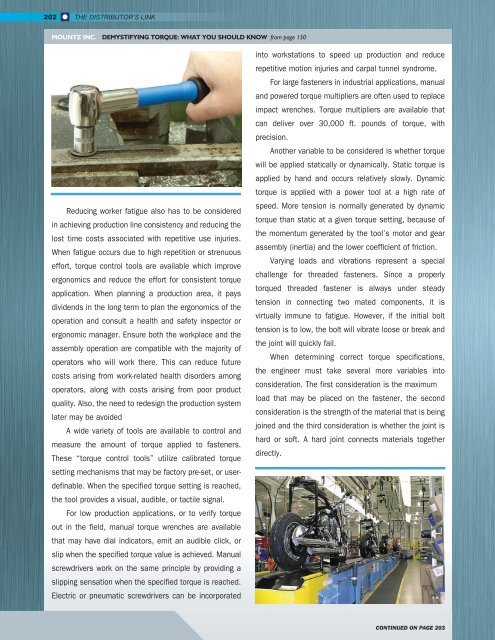FALL 2017
Distributor's Link Magazine Fall Issue 2017 / Vol 40 No4
Distributor's Link Magazine Fall Issue 2017 / Vol 40 No4
You also want an ePaper? Increase the reach of your titles
YUMPU automatically turns print PDFs into web optimized ePapers that Google loves.
202<br />
THE DISTRIBUTOR’S LINK<br />
MOUNTZ INC. DEMYSTIFYING TORQUE: WHAT YOU SHOULD KNOW from page 150<br />
Reducing worker fatigue also has to be considered<br />
in achieving production line consistency and reducing the<br />
lost time costs associated with repetitive use injuries.<br />
When fatigue occurs due to high repetition or strenuous<br />
effort, torque control tools are available which improve<br />
ergonomics and reduce the effort for consistent torque<br />
application. When planning a production area, it pays<br />
dividends in the long term to plan the ergonomics of the<br />
operation and consult a health and safety inspector or<br />
ergonomic manager. Ensure both the workplace and the<br />
assembly operation are compatible with the majority of<br />
operators who will work there. This can reduce future<br />
costs arising from work-related health disorders among<br />
operators, along with costs arising from poor product<br />
quality. Also, the need to redesign the production system<br />
later may be avoided<br />
A wide variety of tools are available to control and<br />
measure the amount of torque applied to fasteners.<br />
These “torque control tools” utilize calibrated torque<br />
setting mechanisms that may be factory pre-set, or userdefinable.<br />
When the specified torque setting is reached,<br />
the tool provides a visual, audible, or tactile signal.<br />
For low production applications, or to verify torque<br />
out in the field, manual torque wrenches are available<br />
that may have dial indicators, emit an audible click, or<br />
slip when the specified torque value is achieved. Manual<br />
screwdrivers work on the same principle by providing a<br />
slipping sensation when the specified torque is reached.<br />
Electric or pneumatic screwdrivers can be incorporated<br />
into workstations to speed up production and reduce<br />
repetitive motion injuries and carpal tunnel syndrome.<br />
For large fasteners in industrial applications, manual<br />
and powered torque multipliers are often used to replace<br />
impact wrenches. Torque multipliers are available that<br />
can deliver over 30,000 ft. pounds of torque, with<br />
precision.<br />
Another variable to be considered is whether torque<br />
will be applied statically or dynamically. Static torque is<br />
applied by hand and occurs relatively slowly. Dynamic<br />
torque is applied with a power tool at a high rate of<br />
speed. More tension is normally generated by dynamic<br />
torque than static at a given torque setting, because of<br />
the momentum generated by the tool’s motor and gear<br />
assembly (inertia) and the lower coefficient of friction.<br />
Varying loads and vibrations represent a special<br />
challenge for threaded fasteners. Since a properly<br />
torqued threaded fastener is always under steady<br />
tension in connecting two mated components, it is<br />
virtually immune to fatigue. However, if the initial bolt<br />
tension is to low, the bolt will vibrate loose or break and<br />
the joint will quickly fail.<br />
When determining correct torque specifications,<br />
the engineer must take several more variables into<br />
consideration. The first consideration is the maximum<br />
load that may be placed on the fastener, the second<br />
consideration is the strength of the material that is being<br />
joined and the third consideration is whether the joint is<br />
hard or soft. A hard joint connects materials together<br />
directly.<br />
CONTINUED ON PAGE 203

















